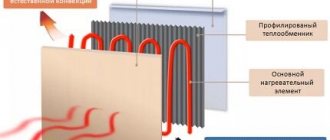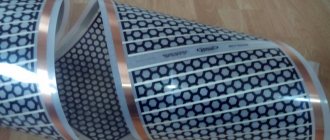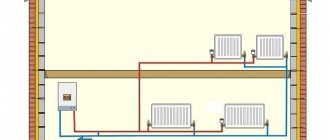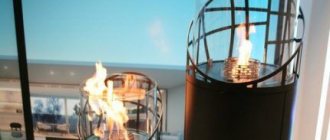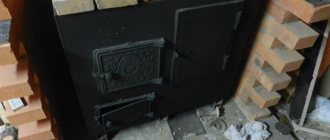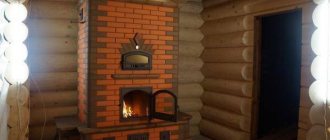A wood chip stove, that is, a heating device that can use thin branches and wood chips as fuel, is an inexpensive analogue of heating devices that operate on:
- natural or liquefied gas;
- gasoline, kerosene, alcohol;
- dry fuel.
In this article we will cover:
- how does a wood chipper differ from other types of stoves?
- how much does a finished wood chip stove cost?
- which models are in greatest demand;
- what fuel can it run on?
Difference from other types of heating devices
Here are the main differences between this device and analogues operating on other types of fuel:
- The main purpose of a wood chip stove is to quickly heat a small volume (1–5 l) of water . Thanks to the design, the fuel burn time is 10-30 minutes, which is quite enough for boiling water or quickly preparing food, such as a small batch of sausages or mushrooms.
- Small dimensions , comparable to portable stoves designed for other types of fuel, allow you to take this device on hikes. When assembled, it is comparable to an army bowler hat, both used by conventional troops of the Soviet and Russian armies, and the legendary Airborne Forces bowler hat, model 1959, and fits perfectly in size. When disassembled or in transit, its size is only slightly larger than a tablet or smartphone.
- Even the most primitive wood-burning stove is more complex and contains more parts than this device. After all, there are no grates, no blower or other parts necessary for the normal operation of a wood-burning stove, and there is also no complex fuel equipment. Due to the simplicity of the design, assembly takes a few minutes and even an inexperienced tourist can carry it out.
- The wood chipper is lighter than most other stoves. The walls and other parts are made of titanium, stainless or tool steel with a thickness of 1–2 mm, and many parts are perforated to create a pyrolysis effect. The thickness of titanium parts is a fraction of a mm. If the parts are made of steel, then the smaller their thickness, the more they are afraid of high temperatures. Therefore, the thicker the part, the less likely it is to deform.
- Economical . By taking a few thick, dry branches with you on a hike, you will be able to use this heating device for a long time, because 100–500 grams of fuel is enough for a single load.
- Due to the simplicity of the design , it is not difficult to make it yourself , which we will discuss in detail in this article.
How does it work?
The principle of operation of a wood chipper is in many ways similar to the principle of operation of other solid fuel stoves - the fuel found in the firebox , that is, wood chips and small branches or cones, burns, releasing heat , which heats the container located on top.
The difference is that the mixture of gases rising upward from the fuel not only actively oxidizes, emitting an open fire, but also mixes with a large amount of secondary air, which enters through holes in the walls.
The same process occurs in wood chip stoves without holes in the side walls, but with a gap between the top of the stove and the heated container.
However, the efficiency of wood chippers is much higher than that of conventional solid fuel stoves, and the reason for this is the excess air supply.
This also causes a very significant disadvantage - this type of heating devices
cannot be operated in minimum power mode , when the fuel slowly smolders with a severe lack of oxygen.
Another significant advantage of excess air intake is the almost complete absence of carbon monoxide in the smoke , that is, carbon monoxide (CO), which during the afterburning process turns into carbon dioxide, that is, carbon dioxide (CO2).
Despite the fact that carbon dioxide is also poisonous, its permissible content in the air is almost 30 times higher than for CO. Therefore, you can use wood chip stoves even in tents with poor ventilation systems , although it is better to use them outdoors.
Indeed, even with the most complete combustion of cellulose, carbon dioxide is released, which displaces oxygen from the air, resulting in oxygen starvation, and this can lead to loss of consciousness or death.
Highland cuisine, self-made from primus and pots.
An easy-to-make high-mountain kitchen can be made on the basis of a tourist stove with a side-mounted tank. The fire in the primus does not go out in any wind, and fuel is consumed more economically. The water in such a kitchen boils twice as fast as usual. To make a kitchen, in addition to a primus, you also need aluminum pans with a capacity of 3.5, 2.5, 1.9 liters.
Primus understands. A central hole is drilled in the gasoline cup so that the conical burner stand fits 2-3 mm into the hole. In a saucepan with a capacity of 3.5 liters, a grid of several rows of holes with a diameter of 5-6 mm is drilled. The rows of holes are slightly longer and higher than the cistern cistern. The bottom row of holes should be level with the bottom of the pan.
A cup for gasoline is riveted into the center of the pan. A tripod 80 mm high is made from stainless steel strips 1 mm thick and 10 mm wide. Its lower bars should tightly cover the gasoline cup. The entire tripod fits into a circle of the same diameter as the bottom of a 1.9 liter pan. The handles of all pots are removed, and wire handles are attached to pots with a capacity of 2.5 and 1.9 liters, just like regular pots. Only one lid is used - from a 2.5 liter pan.
When assembling, the tank with the burner is inserted inside a tripod located at the bottom of the pan with a grate. The burner stand fits into the hole in the cup, and the tank is located next to the grate. The adjustment knob comes out through a hole drilled in the same pan.
For transportation, the entire structure is disassembled. Both pots and the kitchen body are nested inside each other. The smaller pot contains the stand, primus stove, adjustment knob, and matches in sealed packaging. Everything is covered with a lid on top. Kitchen dimensions - 210x120 mm. Weight with gasoline - 1300 g.
To avoid the smell of gasoline, it is recommended to refuel the Primus before using it. For more reliable operation of the kerosene stove, it is recommended to replace the factory rubber seal washer with a homemade one, machined from plastic. This will make it much easier to adjust the flame in the burner.
Folding and non-folding designs - what's the difference?
The main advantage of collapsible models is that the stove, folded and stored in a case, takes up very little space . In most cases, the size of the case with the parts placed in it does not exceed the dimensions of a pack of Belomorkanal cigarettes or a couple of packs of regular cigarettes.
After arriving at the site, the parts are taken out of the case and assembled, which even for a person without experience takes a maximum of 5 minutes. Experienced tourists perform this operation several times faster.
The disadvantage of a collapsible structure is that it is slightly heavier than a non-dismountable one rigidity , so awkward movement can lead to the collapse of the entire structure, after which it will have to be cooled and reassembled.
The non-separable design does not have these disadvantages, but is noticeably larger in size . Most often, a non-separable design is used to make round wood chippers, which are comparable in size to a thermos with a volume of 0.5–2 liters.
Round stoves are not only stronger and stiffer than rectangular collapsible ones, but also have greater efficiency, because additional air enters the afterburning zone, increasing the efficiency of fuel combustion.
Another disadvantage of non-separable round devices is that they are difficult to heat rectangular or elongated containers, that is, most types of soldier’s pots. There are also round collapsible structures , but even when folded they take up noticeably more space than collapsible rectangular ones.
This is due to the fact that the rectangular one is disassembled into separate flat parts, which are then put into a bag, and the round one can only be disassembled into separate blocks , and the size of the folded stove cannot be less than the size of the lower part, because it is usually also the largest.
The remaining parts are turned over and inserted into the lower part, forming a kind of nesting doll. But in round devices , especially with double walls, the supply of secondary air to the afterburning zone is better implemented , which increases the efficiency of the heating device.
Household Primus.
A household primus stove is used when tourists do not have a primus stove of the “Bumblebee” type. The household primus has many disadvantages. The main ones are large weight and high fuel consumption. The disadvantages of a primus stove are also:
The need for periodic cleaning of the nozzle. Some inconvenience during its operation. Weak attachment of legs to body.
To strengthen the attachment of the legs to the body and increase their rigidity to the legs of the kerosene stove in their upper and lower parts, it is recommended to weld a metal triangle.
Advantages and disadvantages of a turbo stove
Sometimes, to increase the efficiency of fuel combustion, the heating device is equipped with a turbocharger powered by AA batteries. This increases the cost of the device, but such a turbo wood chip stove allows you to quickly heat water or food with the same amount of fuel.
In addition, wood chippers with a turbine are made in a non-dismountable version, which is why
they take up much more space .
A serious advantage can be considered the ability to work even on raw fuel , because thanks to the constant flow of air, the wood quickly flares up and burns, releasing the maximum amount of heat.
However, experience shows that turbocharged devices have no real advantages , because even raw wood chips can be dried by stacking them around the stove.
If you take dry alcohol or paraffin-soaked paper napkins with you for kindling, then all the advantages of turbocharging disappear, and there is no point in carrying a rather large and heavy unit with you on a hike, even if some of its parts can be removed.
Therefore, turbocharged devices can rather be classified as exotic toys. Moreover, on a long-term hike the batteries will quickly run out and the heating device will turn into ballast .
Burner for dry alcohol.
For cooking small amounts of food or heating during a rest, a small homemade folding burner is used. The consumption of dry alcohol for preparing a pot of soup from concentrates is usually limited to 60-80 g. However, tablets of dry alcohol are very hygroscopic and require careful moisture-proof packaging. Otherwise, its consumption may double.
Pyrolysis camping devices – truth and myths
Often on the websites of online stores selling these products, some heating devices are called pyrolysis woodchip stoves, arguing that the fuel undergoes a pyrolysis process and releases pyrolysis gas, which then burns in the “pyrolysis” department (afterburner).
In fact, pyrolysis is the thermal decomposition of wood with a lack of oxygen and the almost complete absence of open fire.
In the same heating devices, thermal decomposition of wood occurs with an excess of both primary (in the firebox) and secondary (in the “pyrolyzer”) oxygen , which comes with the air.
Therefore, the name “pyrolysis” is just a marketing ploy , the purpose of which is to attract the attention of people familiar with this term, but who do not delve into the specifics of the operation of the proposed stove model.
However, most "pyrolysis" wood chippers are more efficient than their simple counterparts.
This is due to the fact that the flame receives secondary air entering through the openings in the housing, due to which the hydrocarbons burn more completely, this leads to an increase in the fire temperature for the same amount of fuel .
Often, wood chip stoves that do not have the definition “pyrolysis” in their name are equipped with the same holes, so it is necessary to choose heating devices that provide air supply above the combustion zone, that is, in the afterburning zone.
A little history
The wood chip stove, apparently, was invented by Russian gold miners in Chukotka, when American canned food began to arrive there through Alaska (then still Russian). After Alaska became the property of the United States, many of our compatriots remained there; The surname of the main character of one of the famous stories of Jack London's Alaskan cycle is Souvarine. To the American prospectors and pioneers of the Klondike, the wood chipper was known as the Russian Can Stove.
The properties of wood chips as a means of survival were fully appreciated by Stalin's prisoners. From them, the NKVD guards also learned about the wood chipper. Pre-war survival manuals for scouts include instructions for making wood chips. It was nicknamed Bond's stove thanks to the screenwriter of one of the Bond series - an avid hunter, fisherman and single tourist. The screenwriter and the actor who played Agent 007 in that episode need to say a huge thank you without any pretense. Einstein once put it: “If you have an apple and I have an apple, and we exchange them, then we will each have an apple left. And if you have an idea and I have an idea, and we share them, then each of us will have two ideas.” The idea of the Russian Can Stove saved the lives of dozens of people already during the exploration of the Klondike; by now their number, worldwide, is likely to be in the hundreds, if not thousands.
Use with army bowler hat
Various soldiers' bowler hats, both still in service with the Russian army and airborne ones, are very popular among tourists. Foreign military and tourist bowlers are also often used.
Each of the kettles has a certain shape, so you have to select either a stove for the kettle, or, conversely, a kettle for the wood chipper.
When selecting a heating device and cookware, keep in mind that maximum efficiency will be achieved when the container is completely placed on the device.
Moreover, the distance from any of its edges to the edge of the wood chipper does not exceed 5 mm . If the pot is larger than the stove, it will take longer to heat and boil the water.
If the heating device is larger, then some of the wood chips will be burned in vain , and you will also have to carry extra weight with you.
For traveling by car, this is not critical, but for long hikes, where you have to carry everything yourself, every extra gram turns out to be very important.
After all, you have to choose - either take with you a wood chip that is too large, or a few extra tablets of dry fuel, or some other equally important supply. The exception is models on which you can install 2 containers or a large pan of water at once.
Many manufacturers immediately indicate on their products that this wood chip stove is suitable for an army cauldron.
What is the difference between a steel and titanium device?
Titanium has much greater strength and rigidity than stainless steel , and also withstands high temperatures more easily. Therefore, titanium structures are noticeably lighter than steel ones and do not deform when overheated.
The disadvantage of this metal can be considered its higher cost, as well as the difficulties that arise during independent processing, which will have to be carried out if you decide to make a stove with your own hands.
If we are talking about those structures that can be bought in a store, then titanium ones are lighter and more reliable , therefore they are more preferable for long-distance hiking.
The main dimensions of the individual elements of the oven for cured gasoline are as follows:
The capacity of the pan is 9 and 7 liters with corresponding diameters of 26 and 24 cm. The tank for melting ice has an external diameter of 40 cm, an internal diameter of 34 cm. The height of the tank is 17 cm. Material is preferably stainless steel with a thickness of 0.2-0.3 mm.
The technical characteristics of this stove for cured gasoline are as follows. To boil 14 liters (8 and 6 liters in two pans) of ice water, you need 600 grams of solidified gasoline. Boiling time is 100 minutes.
Based on materials from the book Homemade Travel Equipment. Lukoyanov P.I.
Cost of a ready-made camping device in a store
We have compiled a table that includes the most popular models of these devices:
| Model | Short description | Price in rubles | Seller or manufacturer website |
| Biolite CookStove | Turbo oven with batteries, stainless steel body. | 9588 | krasnodar.bready.ru |
| Glow "Track" | Round, non-separable, secondary air enters the afterburner. Weight 400 g, comparable in size to a can of stew. | 1990 | ozon.ru |
| PS1500T | Non-separable with turbocharging. Transport dimensions 14x14x14 cm, weight 720 g. The set includes a fabric case. The operating time of the boost from a set (2 pcs) of batteries is 50 hours. | 2549 | www.smartcamping.ru |
| Survivalist No. 5 (double) VZHK | The device is made in Russia. Stainless steel, low afterburning of gases, boiling time of water in an army airborne cauldron is 5 minutes, weight 1230 g (metal thickness 1.5 mm). 3 levels of grate bars for various fuels, a double groove system that increases the strength of the assembled structure, a hinged door with a lock. One of the walls is solid for installation downwind. It is an analogue of the well-proven Pereval stove, accessible only through the VKontakte social network. | 710 | vizhivaika.ru |
| Biohit T15 | Stainless steel, good flow of secondary air (the afterburner is not included in the standard package, you must either purchase it separately or take an extended kit). Even the basic kit includes a durable case for carrying parts. | 890 | bioheat.ru |
| Toaks Titanium Backpacking Wood Burning Stove | The titanium body, a weak flow of primary air and a strong flow of secondary air bring the fuel combustion mode closer to pyrolysis, increasing the efficiency of the stove. When assembled, it is a cylinder with a diameter and height of 105 mm. Weight 225 gr. | 4030 | sport-marafon.ru |
| PSH-2 | Tool steel, afterburning chamber (inner casing, after installation of which secondary air moves between the outer and inner casings), lockable firebox door. The kit includes a bag for carrying parts, as well as 2 sets of skewers for frying shish kebab. The weight of the complete set is 1790 g, the weight of the basic set is 920 g. | 1850 | vizhivai.com |
| PiroStove CAMP | Round, folding - consisting of blocks, the size in the assembled and transport state is the same 21.5x30.5 cm. Weight 1750 g. Case material: food-grade heat-resistant stainless steel. Suitable for a company of 3-4 people. | 3999 | pirostove.ru |
What can be used as fuel?
These heating devices are omnivorous and are able to work both on wood waste , that is:
- wood chips;
- shavings;
- sawdust,
and on forest debris , that is, cones, branches or pieces of bark.
In this case, at least 75% of the fuel must be chopped or crushed wood , the minimum dimensions of which are:
- length 4 cm;
- width 1 cm;
- thickness 0.5 cm.
The maximum fuel dimensions are limited only by the volume of the firebox - when fully loaded, it must accommodate at least 5 fuel cells.
If there are fewer of them, they will not burn efficiently. Instead of chopped wood you can use cones if they are the right size.
Also suitable as fuel:
- dry leaves;
- dry pine needles;
- dry or fresh bark;
- stems of bushes.
Does it make sense to take it on hikes?
Not all tourists prefer to take wood chips with them, because a gasoline or gas stove is much more efficient and will heat water faster.
Therefore, some tourists perceive these devices as an exotic toy that they can show off to their friends, but have nowhere to actually use.
However, on multi-day hikes with a small group (2-3 people) or alone, this heating device is more effective than other stoves.
After all, the fuel is lying under your feet, which means you don’t have to carry it with you. In addition, gas or gasoline will sooner or later run out, but forests and even open forests will always provide fuel for this device.
Tourist camping stove with a side-mounted tank.
A primus of this type has a mechanical device for cleaning the nozzle from the inside and does not require primus needles. When the kerosene stove is in working position, there is free access to the gasoline tank, and if necessary, it can be easily cooled.
When using a pan with a wide bottom, the flame hits the tank and heats it, although there is a special screen that closes the tank in the working position. Therefore, the racks for the pan need to be lengthened and made retractable.
Using such a Primus, you can boil a pot of water in 15 minutes without much hassle. One refill is enough for an hour of burning. The fuel is regular motor gasoline. A tourist group needs to have 2-3 such primus stoves for cooking.
How to use such a stove correctly?
There are several rules that will help not only speed up the heating of water or food, but also reduce the risk of overheating of the housing, as well as the severity of the consequences of overheating, that is, thermal deformation and the resulting jamming of parts:
- For ignition you need to use dry kindling and fuel . After all, it is difficult to ignite wet wood even with the help of a hunting match or dry fuel.
- The firebox must be completely filled with kindling and fuel, leaving some space for the movement of air and smoke. This will not only speed up ignition, but also reduce the risk of overheating, because you will not have to add fuel until the stove returns to normal operation.
- If one load of fuel is not enough, then branches and other small wood should be placed behind and on the sides of the heating device at a distance of 2–10 cm. When the wood chipper reaches operating mode, the walls will heat up and begin to dry the fuel. This rule applies to both simple and turbocharged devices.
- It is necessary to close the door after the smoke rising above the stove becomes colorless . This usually happens 1-3 minutes after ignition.
- put a pot on the stove only after all the fuel has completely ignited and some of it has burned out and turned into coals (usually this takes 5–10 minutes). If you place the container earlier, the stove’s operating mode will be disrupted, which will sharply increase the likelihood of overheating. In addition, if you install the container earlier, it will become covered with soot, and heating a large volume of water will take longer due to the disruption of the combustion regime.
- If the structural are deformed , then they must be disassembled immediately after the oven to a temperature of 70–100 degrees (for this you will need canvas gloves). If you wait until it cools completely, the structure may jam and it will be quite difficult to disassemble it.
- If some part of the stove is hot and turns red, then you cannot add more fuel . In addition, after cooling and disassembling, it is necessary to inspect this part for defects. If there are defects, the part requires replacement.
Emergency
Finally, let's see how to make a wood chipper as a last resort from scrap materials. At pos. 1-3 fig. the same Russian Can Stove that survived unchanged to Bond’s stove. This kind of wood chipper is primarily used for heating: the combustion in it is quiet and superficial. A surface burning wood chipper produces a weak flame, but a lot of soft heat. When starting in a tent, you can use a metal bowl as a tray, into which small pebbles of approx. same size. Not sand, you need air flow! You also need to place something under the bowl that is not self-igniting and does not conduct heat well: the bottom of the stove, when the load burns out, heats up to 300-400 degrees, and the bottom of the bowl through pebbles 2-3 cm in diameter to 140-160 degrees.
Camping stoves made from cans
By the way, the best fuel load for an emergency surface burning wood chipper is a tightly stuffed roll of toilet paper, also tightly packed medical cotton wool, etc. loose fuel, which contains more cellulose and less of something else. To ignite, you need 30-100 ml of alcohol or any other flammable liquid, strong alcohol (vodka, cognac, local moonshine) or vegetable oil. The fuel load is pierced along the axis to the bottom with a pencil, writing pen or sharpened stick, doused with kindling and set on fire. It burns for a long time, without soot, and produces a lot of heat.
If among the empty cans there is a pair that fits into one another, then from the cans it is possible to quickly assemble a wood chipper with a mixed combustion mode that is more economical and suitable for making tea or soup in a mug, pos. 4 and 5. The holes, of course, do not have to be so neat; they can simply be punched with a knife. If the stove will be loaded with loose fuel, holes in the inner can must be pierced from the inside so that burrs do not interfere with loading. Also, 1-3 rows of holes are punched at the top in the shell (cylindrical sidewall) of the inner can. Branch fuel is loaded to the bottom edge of the holes in the top row, pos. 5. These, of course, are not all options for wood chip stoves as a last resort; Other quite effective designs of camp stoves made from cans are also possible, see for example. video:
Comparison of different models
It is impossible to compare the effectiveness of wood chip stoves based on descriptions in stores, because sellers are interested in selling their goods, so they often exaggerate the advantages and hush up the disadvantages of the models.
We decided to objectively talk about the pros and cons of the most popular heating devices, focusing on the opinions of the inhabitants of various forums and videos on YouTube.
After all, both the posts in the forums and the videos posted were left by people who actually used certain models of stoves and formed some kind of opinion about them.
Pass
This wood chipper is sold through the social network VKontakte, but the manufacturer is unknown. Nevertheless, the stove is in demand, because its parts are made of titanium, so it is lighter than its steel counterparts and can withstand overheating more easily .
However, the rather high price (more than 2,000 rubles) scares off many potential buyers. On the same page there are also steel analogues under the same brand. They are noticeably heavier and cheaper, so a potential buyer will be able to choose what is best suited for his conditions.
Survivalist 5 double VZhK
Quite a large Russian stove, on which you can simultaneously install 2 army pots.
The wood chipper is available in various versions , which differ in the thickness of the metal.
With careful use, even a thickness of 1 mm, and such a design weighs 820 grams, lasts for several years , then some of the parts become deformed and they have to be either straightened or replaced.
The Survivalist has no special abilities ; it is an ordinary stove with a small afterburning zone and not too high efficiency.
Glow "Track"
Folding round wood chipper designed for heating a small amount of water (0.5–1 l). Despite the small thickness of the metal, it is quite resistant to deformation.
Most of those who have purchased and actively use it notice that when heating a small volume of water, it is more efficient than most rectangular analogues.
However, trying to heat a larger volume of water leads to serious problems. After all, you have to remove the container from the heating device, fill the wood chipper with new fuel and return the container to its place. Therefore, it is still suitable for a solo hike, but for a company of 2 or more people, it is better to take something else .

